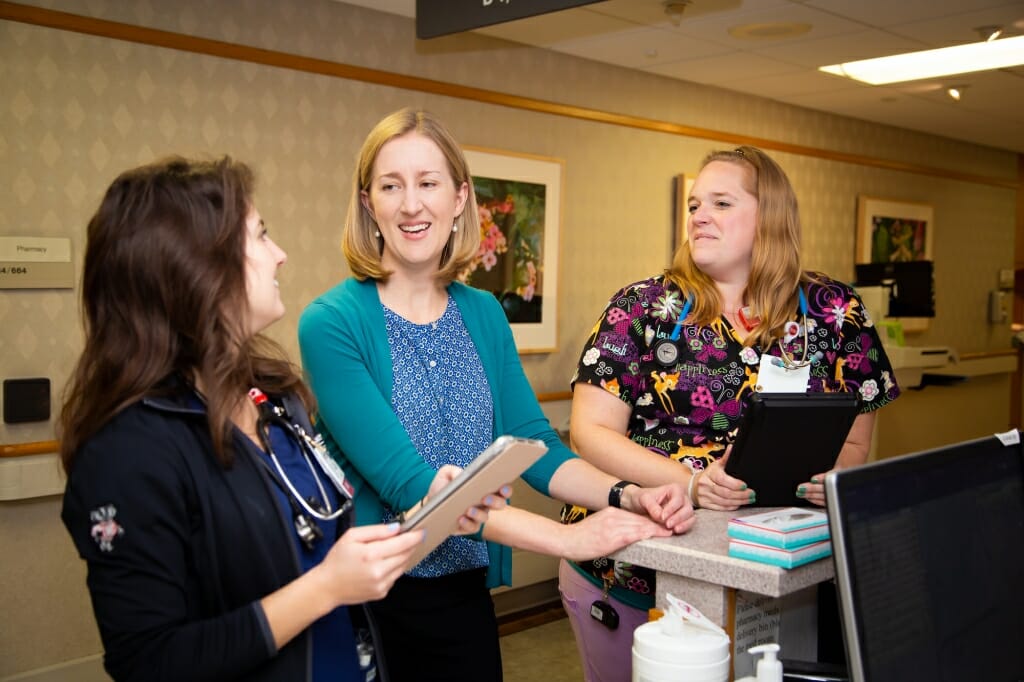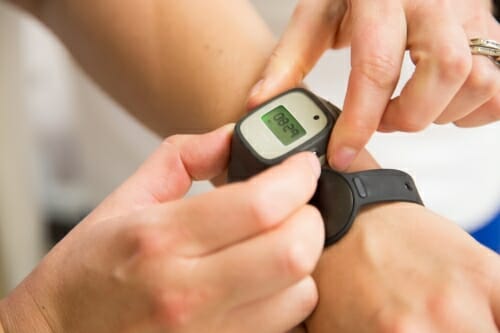Are Fitbits the answer to nurse fatigue?

School of Nursing Professor Linsey Steege, center, talks with nurses Emily Jolliffe, at left, and
Christina Butzine, at right. Both are RNs in the transplant unit at UW Hospital. Photo by Alex Andre
Activity trackers might lead to better outcomes for hospital patients — when nurses wear them.
Millions of individuals already use tiny fitness trackers to prompt physical activity in hopes of improving their health. Now a UW–Madison School of Nursing professor is taking them a step further by using them to track nurse movement in hospitals. The hope is to uncover important data about what causes fatigue in the work environment and what health systems can do to minimize its impact not only on nurses but on patients as well.
Hospital nurses spend a lot of time on their feet. Their work is physical, taxing, even grueling. Lifting patients, pushing and pulling heavy equipment, moving supplies. Factor in 12-hour shifts, irregular schedules, constant interruptions and all the other demands of life, and it is no wonder that nurses struggle with fatigue.
While a frustration for individual nurses, fatigue is also an even bigger problem than that. Linsey Steege, a human factors engineer and UW–Madison nursing professor, says fatigue contributes to medical errors and staff attrition, both of which can have devastating consequences for patients while also driving up cost for health systems and consumers.
“I became interested in focusing on how to improve how we support nurses so that they in turn can be safe and provide the highest quality patient care,” she said. “[But] when I looked around, there was a lot of research on physical fatigue [and] sleep deprivation for medical residents, but much less on how nursing work is contributing to fatigue and how fatigue is contributing to stress, burnout, and worst of all, medical error. “

A nurse adjusts an activity tracker. Steege is conducting a study that uses the trackers in which nurses wear activity trackers to record steps, heart rate and sleep information. Photo by Alex Andre
Fatigue is also a key reason that nurses leave the field, which already faces a workforce shortage that challenges health systems, particularly in rural areas, to provide safe and effective care.
As an engineer, Steege looks specifically at how nurses operate within and are affected by the workplace in order to determine what health systems and the nurses themselves could change to minimize fatigue and its effects. Yet before she could offer a solution, Steege had to figure out what factors cause fatigue and in what circumstances.
The first step is collecting data, and for Steege that was also the first challenge. “Can we directly measure the demands that add up to fatigue without adding more burden? Asking nurses who are already struggling with fatigue to do more—even something like filling out a survey at the end of a 12-hour shift—is problematic,” Steege said.
“It further burdens an already burdened staff, and it potentially compromises the integrity of the data if nurses wait until a later time when they feel better rested or recovered to provide feedback. Their recollections may not be as accurate as their impressions at the moment.”
While Steege’s research does involve some direct nurse feedback during shifts, the key to her study is passive data collection.
This is where Fitbits come in. The nurses in Steege’s study wear the activity trackers that record steps, heart rate and sleep information, all of which she analyzes to determine how work demands influence fatigue levels.
Steege actually uses a variety of passive data collection tools that provide her with more detail than the consumer wearable trackers capture. She also taps into other data sources to gather additional factors about the work environment—things like noise levels, volume of pages and calls, time spent in electronic health records, nurse movement patterns, shift staffing reports, and patient acuity data that indicates how “sick” a particular patient load is—that she layers on top of the physical activity data to get a clearer picture of the toll of any given shift on any given nurse.
She compares the approach to the oil-change monitoring on cars. Auto engineers design the monitoring systems to capture not only miles driven but also terrain, weather conditions, and even driving speed and style to determine when an oil changes is needed. Car owners do not have to manually enter the quality of roadways or wind velocity on a particularly trip. The vehicles do all that automatically — passively — and then recommend when maintenance is required. The result is that maintenance schedules vary from car to car, driver to driver.
Steege is trying to do the same thing with the nurses she studies: gather as much information about their work environment and how they interact with it to determine what factors are the biggest contributors to fatigue, when in a shift those factors are most problematic, and, ultimately, how much fatigue is too much. Eventually Steege wants to develop strategies that are flexible enough to account for the variability of nursing practice—from shift to shift and from nurse to nurse—and that enable health systems to design staffing policies and schedules that recognize the causes of fatigue and minimize the impact of it on nurses and patients.
“That is what human factors engineering is—designing or modifying work environments to optimize performance while keeping people safe,” Steege said. “The hospital is a work environment. We tend to focus on patient safety, but we need to consider nurse safety and wellbeing as well. If health systems do not account for the burden of fatigue on their nurses, medical errors and turnover will both increase, along with cost.”
Rebecca Rankin is a the director of informatics for UW Health, and two of her nursing staff members support Steege’s study at University Hospital. Rankin says there are myriad reasons why the research is important, namely nurse well-being and patient outcomes. She also welcomes the opportunity to look at nursing work scientifically. “For me it’s a real exciting opportunity to use data to positively impact how we take care of ourselves as nurses and to understand what contributes to nurse fatigue in the inpatient environment,” she said.
Nurses are the population Steege studies, but she encourages health systems to look closely at fatigue and other wellness issues for all providers. She points out that when a nurse, physician or therapist is unhealthy, care is inherently compromised. So if health systems are genuinely interested in providing high quality care, she says, they must attend to the health and wellbeing of their providers.
“We cannot push the problem onto nurses by solely emphasizing self-care as a solution to fatigue,” Steege said. “It has taken us a while to get here, but health systems are realizing that work environments and policies that do not promote or that actually undermine health in providers are problems for the health system to resolve.”
Tags: health, research, School of Nursing




